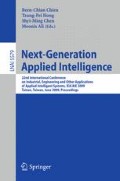Abstract
A trajectory-based point tracker using chaos evolutionary programming (CEP) algorithm is proposed in this paper. While motion constraints such as rigidity and small motion which are imposed by previous approaches are liberated, the proposed CEP is proved to be effective for establishing point correspondence between two consecutive frames sampled at a fixed interval. The whole point trajectory within the sample interval is then reconstructed by polynomial interpolation. Our experimental results demonstrate that the proposed point tracker can accurately locate target under different kinds of situations like object deformation, occlusion, and sudden motion as well.
Access this chapter
Tax calculation will be finalised at checkout
Purchases are for personal use only
Preview
Unable to display preview. Download preview PDF.
References
Wang, Y., Baciu, G.: Human motion estimation from monocular image sequence based on cross-entropy regularization. Pattern Recognition Letters 24, 315–325 (2003)
Mezouar, Y., Chaumette, F.: Model-free optimal trajectories in the image space: application to robot vision control. In: Proceedings of the IEEE Conference on Computer Vision and Pattern Recognition, pp. 1155–1162 (2001)
Sturm, P.: Structure and motion for dynamic scenes - the case of points moving in planes. In: Heyden, A., Sparr, G., Nielsen, M., Johansen, P. (eds.) ECCV 2002. LNCS, vol. 2351, pp. 867–882. Springer, Heidelberg (2002)
Rangarajan, K., Shah, M.: Establishing motion correspondence. CVGIP: Image Understanding 54, 56–73 (1991)
Mehrotra, R.: Establishing motion-based feature point correspondence. Pattern Recognition 31, 23–30 (1998)
Salari, V., Sethi, I.K.: Feature point correspondence in the presence of occlusion. IEEE Trans. Pattern Anal. Mach. Intell. 12, 87–91 (1990)
Sethi, I.K., Jain, R.: Finding trajectories of feature points in a monocular image sequence. IEEE Trans. Pattern Anal. Mach. Intell. 9, 56–73 (1987)
Wang, Y.: Feature point correspondence between consecutive frames based on genetic algorithm. International Journal of Robotics and Automation 21, 35–38 (2006)
Fogel, D.B.: Evolutionary Computation: Toward a New Philosophy of Machine Intelligence. IEEE Press, Piscataway (1999)
Guo, S.M., Shieh, L.S., Chen, G., Coleman, N.P.: Observer-type kalman innovation filter for uncertain linear systems. IEEE Trans. Aerospace Elec. Syst. 37, 1406–1418 (2001)
Li, B., Jiang, W.S.: Optimizing complex functions by chaos search. Cybernetics and Systems 29, 409–419 (1998)
Yan, X.F., Chen, D.Z., Hu, S.X.: Chaos-genetic algorithms for optimizing the operating conditions based on RBF-PLS model. Computers and Chemical Engineering 27, 1393–1404 (2003)
Halton, J.H.: On the efficiency of certain quasi-random sequences of points in evaluating multidimensional Integrals. Numerische Mathematik 2, 84–90 (1960)
Van Der Corput, J.C.: Verteilungsfunktionen. Proc. Kon. Akad. Wet. Amsterdam 38, 1058–1066 (1935)
Guo, S.M., Liu, K.T., Tsai, J.S.H., Shieh, L.S.: An observer-based tracker for hybrid interval chaotic systems with saturating inputs: The chaos-evolutionary-programming approach. Computers and Mathematics with Applications 55, 1225–1249 (2008)
Author information
Authors and Affiliations
Editor information
Editors and Affiliations
Rights and permissions
Copyright information
© 2009 Springer-Verlag Berlin Heidelberg
About this paper
Cite this paper
Guo, SM., Hsu, CY., Wu, PN., Tsai, J.SH. (2009). A Trajectory-Based Point Tracker Using Chaos Evolutionary Programming. In: Chien, BC., Hong, TP., Chen, SM., Ali, M. (eds) Next-Generation Applied Intelligence. IEA/AIE 2009. Lecture Notes in Computer Science(), vol 5579. Springer, Berlin, Heidelberg. https://doi.org/10.1007/978-3-642-02568-6_22
Download citation
DOI: https://doi.org/10.1007/978-3-642-02568-6_22
Publisher Name: Springer, Berlin, Heidelberg
Print ISBN: 978-3-642-02567-9
Online ISBN: 978-3-642-02568-6
eBook Packages: Computer ScienceComputer Science (R0)

